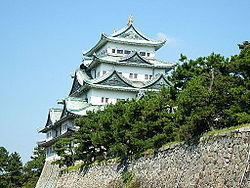Naka-ku, Nagoya
|
Naka 中区 |
|
|---|---|
| Ward | |
| Naka Ward | |

|
|
 Location of Naka-ku in Nagoya |
|
| Coordinates: 35°10′7″N 136°54′37″E / 35.16861°N 136.91028°ECoordinates: 35°10′7″N 136°54′37″E / 35.16861°N 136.91028°E | |
| Country | Japan |
| Region |
Tōkai region Chūbu region |
| Prefecture | Aichi |
| Area | |
| • Total | 9.38 km2 (3.62 sq mi) |
| Population (November 2011) | |
| • Total | 79,410 |
| • Density | 8,470/km2 (21,900/sq mi) |
| Time zone | Japan Standard Time (UTC+9) |
| - Tree | Ginkgo biloba |
| - Flower | Pansy |
| Phone number | 052-241-3601 |
| Address | Sakae 4-chome, Naka-ku, Nagoya-shi, Aichi-ken 464-8644 |
| Website |
www |
Naka Ward (中区 Naka-ku?) is one of the 16 wards of the city of Nagoya in Aichi Prefecture, Japan. As of 2011, the ward has an estimated population of 79,410 and a population density of 8,470 persons per km². The total area is 9.38 km².
Naka Ward is located in the center of Nagoya city. Largely hemmed in by Sakura-dōri (桜通り), Ōtsu-dōri (大津通り), Fushimi-dōri (伏見通り) and Tsurumai-dōri (鶴舞通り), it contains the main shopping area of Sakae, a massive air-conditioned 5 square-kilometer underground mall) and the 'after-five' semi-red light districts of Nishiki and Shin-sakae.
Naka Ward was one of the original four wards of the city of Nagoya, established on April 1, 1908. On February 1, 1944 a portion of Naka Ward was divided out to become Sakae Ward (栄区 Sakae-ku?), but was merged back into Naka Ward on November 3, 1945. Most of the area was completed destroyed during the Bombing of Nagoya in World War II. After the war, the layout of the streets was changed to a grid pattern, with wide streets serving as firebreaks. The city is especially proud of Sakae's 100-meter road (100メートル道路) so named because of its width. There are small parks and areas for public performances in the area between two four-lane roads that service the city centre. The road is about 100 m (328 ft) in width, and 1 km (0.6 mi) in length.
...
Wikipedia

